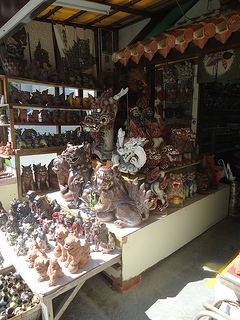Ryukyuan pottery

- Okinawan: 焼物 (yachimun)
Pottery was first introduced to Ryûkyû from China during the Gusuku Period (c. 1100s-1400s). Tsuboya wares, produced in the Tsuboya district of Naha, are the most well-known style of Ryukyuan pottery, and the most strongly associated with Ryûkyû. In addition to dishes, vessels, and roof tiles, Ryukyuan pottery is especially known for the production of funerary urns, and shisa, lion-like guardians placed on rooftops and at gates to protect homes and other spaces from evil spirits.
The court ordered many of the potters in the kingdom to relocate to the Tsuboya district in 1682, creating Tsuboya as a major center of pottery production, and sparking the emergence of a distinctive Tsuboya style. Kumejima, Miyakojima, and Ishigakijima remain major centers of pottery production as well.
Up until the Meiji period, Tsuboya remained a center of production of relatively simple arayachi (荒焼, "rough wares"), or unglazed ceramics. It was only in the Taishô period that, seeing the great popularity of Arita wares in the mainland Japanese market and seeking to expand their market share, the Tsuboya potters began producing jôyachi (上焼, "completed wares"), that is, glazed ceramics, with elaborate designs of fish, dragons, and the like.
A handful of influential ceramics artists, including Aragaki Eizaburô, Kinjô Jirô, and Kobashigawa Eishô, led the Tsuboya area in developing further in the post-war, into what it is today.
References
- Gallery labels, Okinawa Prefectural Museum.
- Gallery labels, "The Tsuboya-yaki region," Gallery 4: Minzoku, National Museum of Japanese History.